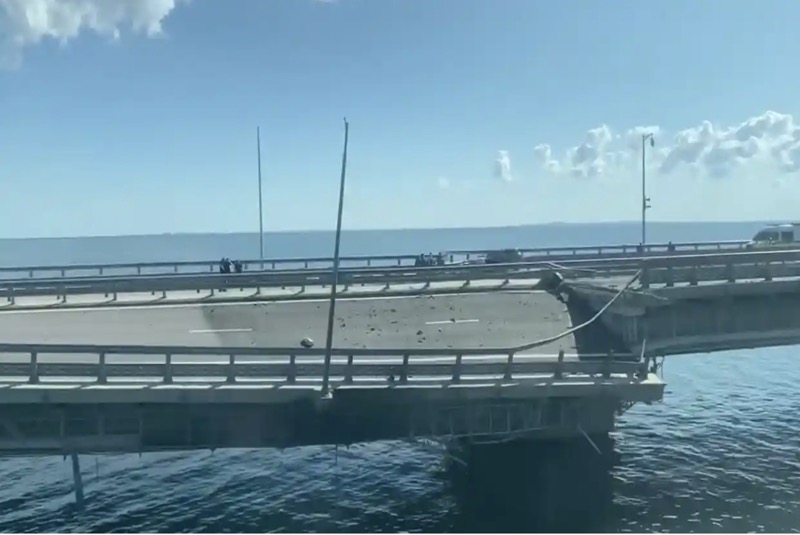The bridge connecting mainland Russia across the Kerch Strait with the illegally annexed Ukrainian peninsula of Crimea was seriously damaged on July 17 2023, in what appears to be a successful strike by naval drones.
While there has been no official confirmation from Kyiv yet, the attack on a vital Russian supply line fits well into the overall picture of the Ukrainian counteroffensive that has been under way since early June. But the strike is also hugely symbolic, demonstrating Ukraine’s ability to undermine the unlawful Russian claim to Ukrainian territory.
The partial destruction of the road bridge followed unsuccessful recent attempts to strike both the bridge and Sevastopol harbour, the main base of the Russian Black Sea fleet. Monday’s attack on the bridge left its parallel railway track undamaged, but all road traffic came to a standstill.
Russia is likely to be able to render the bridge operational again as it did after an earlier attack in October 2022. But these repairs will take time, as they did before, and the limited use of the bridge during peak holiday season will serve as a reminder to ordinary Russians of a war that is not without cost to them.
Less than four weeks ago, Ukraine also carried out a precision missile strike against the two parallel Chonhar bridges, which provide a vital connection between Crimea and the Russian-occupied part of Kherson region on Ukraine’s mainland.
Crimea’s crucial role
These may seem symbolic strikes of little strategic significance. And on their own, they probably would be, especially as the much-anticipated Ukrainian counteroffensive has been slow in taking back Russian-occupied territory.
But these strikes are part of a broader campaign to disrupt Russian supply lines, which is vital to wear down well-entrenched Russian defences across some 1,000km of front line in eastern Ukraine.
Crimea plays a crucial role in this context. The links between Russia and southern Ukraine–via the Kerch strait and Chonhar bridges–are potentially vital for supplies to reach Moscow’s occupation forces in the southern Kherson region. This will especially be the case as Ukraine becomes more capable to hit rail and road connections along the so-called Crimean land bridge.
Kherson and, further to the east, the Russian-occupied parts of Ukraine’s Zaporizhzhia and Donetsk regions, are critical to providing Crimea with freshwater for drinking and farming. Water is already in short supply following Russia’s destruction of the Nova Kakhovka hydro-electric dam in early June.
Little wonder then that Crimea has been heavily militarised since Russia’s illegal annexation of the peninsula in March 2014 – or that Russian troops there have increasingly been threatened by different anti-Putin partisan groups. These include both Russian volunteers and indigenous Crimean Tatars who have become more active since the start of the Ukrainian counteroffensive.
Similar attacks occured in August 2022 at a time when Ukraine was gearing up for a successful advance against Russian forces that were eventually driven out of the northern parts of Kherson region.
Putin’s vulnerabilities
What is really important in all of this is that these same Russian vulnerabilities still exist, in Crimea and in other parts of the hinterland behind the Russian defences in occupied Ukrainian territory. The strike on the Chonhar bridges on June 22 and on the Kerch strait bridge on July 17 exposes them once more for all to see.
This exposure is also symbolically highly significant. The Russian president, Vladimir Putin, is trying to reassert his authority after the abortive mutiny by his erstwhile ally, Wagner boss Yevgeny Prigozhin. So the damage to Putin’s bridge across the Kerch strait further chips away at his strongman image of invincibility.
And again, it matters that these attacks happened in Crimea. Of all the territories invaded and still occupied by Russia, this is the one area in which the Russian occupation was overwhelmingly welcomed.
What’s more, it is also the one area that Russians are likely to care about, regardless of how detached from reality historical claims to Crimea might sound. So appearing unable to prevent Ukrainian attacks in and on Crimea also exposes a potentially significant personal vulnerability of Putin’s regime and the myths on which it is partially built.
This does not mean that the Kremlin is about to lose its grip on Crimea. But Ukrainian claims that it will eventually be able to retake the peninsula, if need be by force, have just become a bit more believable.
At a time when debate over how to end Russia’s war on aggression against Ukraine–at the negotiation table or on the battlefield–continues in the west, these strikes serve as a useful reminder that this is Ukraine’s war. It is ultimately decisions in Kyiv that will determine whether, where, and how it can be won.
-30-
Copyright©Madras Courier, All Rights Reserved. You may share using our article tools. Please don't cut articles from madrascourier.com and redistribute by email, post to the web, mobile phone or social media.Please send in your feed back and comments to [email protected]











